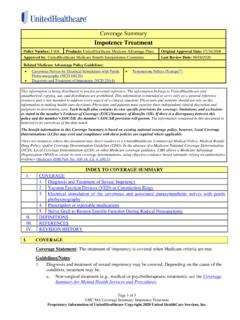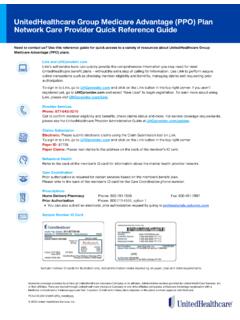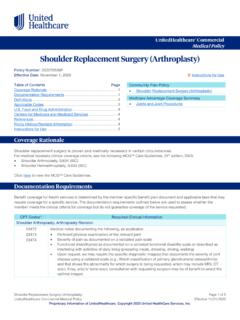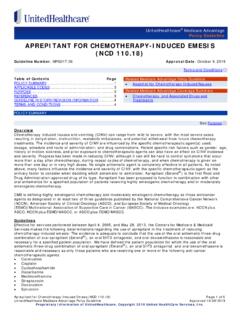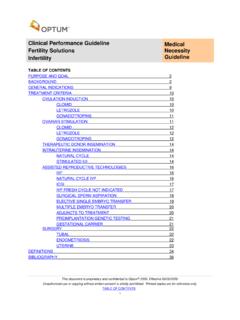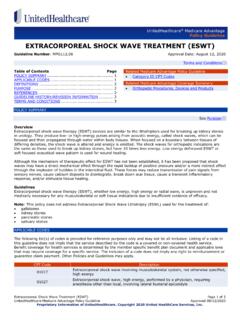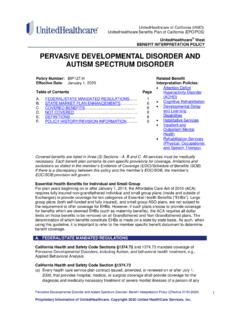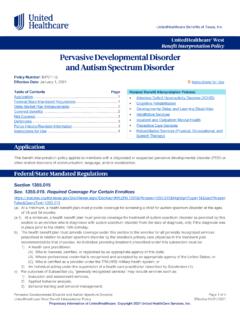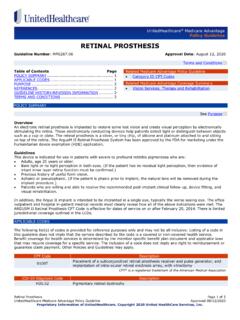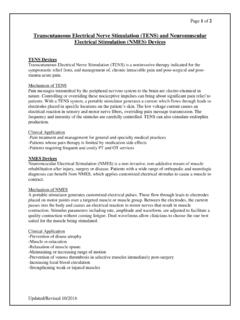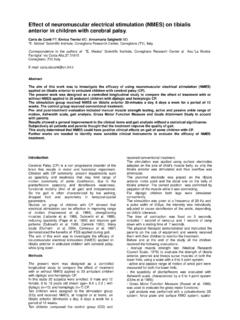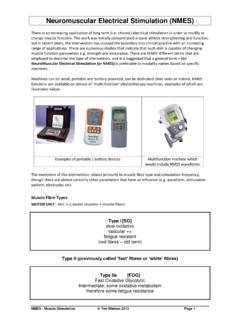Transcription of NEUROMUSCULAR ELECTRICAL STIMULATION …
1 NEUROMUSCULAR ELECTRICAL STIMULATION (NMES) (NCD ) Page 1 of 3 UnitedHealthcare Medicare Advantage Policy Guideline Approved 07/08/2020 Proprietary Information of UnitedHealthcare. Copyright 2020 United HealthCare Services, Inc. NEUROMUSCULAR ELECTRICAL STIMULATION (NMES) (NCD ) Guideline Number: Approval Date: July 8, 2020 Table of Contents Page POLICY SUMMARY .. 1 APPLICABLE CODES .. 2 PURPOSE .. 2 REFERENCES .. 2 GUIDELINE HISTORY/REVISION INFORMATION .. 3 TERMS AND CONDITIONS .. 3 POLICY SUMMARY Overview NEUROMUSCULAR ELECTRICAL STIMULATION (NMES) involves the use of a device which transmits an ELECTRICAL impulse to the skin over selected muscle groups by way of electrodes. There are two broad categories of NMES. One type of device stimulates the muscle when the patient is in a resting state to treat muscle atrophy.
2 The second type is used to enhance functional activity of neurologically impaired patients. Guidelines Treatment of Muscle Atrophy Coverage of NMES to treat muscle atrophy is limited to the treatment of disuse atrophy where nerve supply to the muscle is intact, including brain, spinal cord and peripheral nerves, and other non-neurological reasons for disuse atrophy. Some examples would be casting or splinting of a limb, contracture due to scarring of soft tissue as in burn lesions, and hip replacement surgery (until orthotic training begins). (See of the NCD Manual for an explanation of coverage of medically necessary supplies for the effective use of NMES.) Use for Walking in Patients with Spinal Cord Injury (SCI) The type of NMES that is used to enhance the ability to walk of SCI patients is commonly referred to as functional ELECTRICAL STIMULATION (FES).
3 These devices are surface units that use ELECTRICAL impulses to activate paralyzed or weak muscles in precise sequence. Coverage for the use of NMES/FES is limited to SCI patients for walking, who have completed a training program which consists of at least 32 physical therapy sessions with the device over a period of three months. The trial period of physical therapy will enable the physician treating the patient for his or her spinal cord injury to properly evaluate the person's ability to use these devices frequently and for the long term. Physical therapy necessary to perform this training must be directly performed by the physical therapist as part of a one-on-one training program. The goal of physical therapy must be to train SCI patients on the use of NMES/FES devices to achieve walking, not to reverse or retard muscle atrophy.
4 Coverage for NMES/FES for walking will be covered in SCI patients with all of the following characteristics: Persons with intact lower motor units (L1 and below) (both muscle and peripheral nerve); Persons with muscle and joint stability for weight bearing at upper and lower extremities that can demonstrate balance and control to maintain an upright support posture independently; Persons that demonstrate brisk muscle contraction to NMES and have sensory perception ELECTRICAL STIMULATION sufficient for muscle contraction; Persons that possess high motivation, commitment and cognitive ability to use such devices for walking; Related Medicare Advantage Policy Guideline Electrotherapy for Treatment of Facial Nerve Paralysis (Bell's Palsy) (NCD ) Related Medicare Advantage Coverage Summary Stimulators: ELECTRICAL and Spinal Cord Stimulators UnitedHealthcare Medicare Advantage Policy Guideline Terms and Conditions See Purpose NEUROMUSCULAR ELECTRICAL STIMULATION (NMES) (NCD ) Page 2 of 3 UnitedHealthcare Medicare Advantage Policy Guideline Approved 07/08/2020 Proprietary Information of UnitedHealthcare.
5 Copyright 2020 United HealthCare Services, Inc. Persons that can transfer independently and can demonstrate independent standing tolerance for at least 3 minutes; Persons that can demonstrate hand and finger function to manipulate controls; Persons with at least 6-month post recovery spinal cord injury and restorative surgery; Persons without hip and knee degenerative disease and no history of long bone fracture secondary to osteoporosis; and Persons who have demonstrated a willingness to use the device long-term. NMES/FES for walking will not be covered in SCI patient with any of the following: Persons with cardiac pacemakers; Severe scoliosis or severe osteoporosis; Skin disease or cancer at area of STIMULATION ; Irreversible contracture; or Autonomic dysflexia.
6 The only settings where therapists with the sufficient skills to provide these services are employed, are inpatient hospitals; outpatient hospitals; comprehensive outpatient rehabilitation facilities; and outpatient rehabilitation facilities. The physical therapy necessary to perform this training must be part of a one-on-one training program. Additional therapy after the purchase of the DME would be limited by our general policies in converge of skilled physical therapy. APPLICABLE CODES The following list(s) of codes is provided for reference purposes only and may not be all inclusive. Listing of a code in this guideline does not imply that the service described by the code is a covered or non-covered health service. Benefit coverage for health services is determined by the member specific benefit plan document and applicable laws that may require coverage for a specific service.
7 The inclusion of a code does not imply any right to reimbursement or guarantee claim payment. Other Policies and Guidelines may apply. HCPCS Code Description E0744 NEUROMUSCULAR stimulator for scoliosis E0745 NEUROMUSCULAR stimulator, electronic shock unit E0764 Functional NEUROMUSCULAR STIMULATION , transcutaneous STIMULATION of sequential muscle groups of ambulation with computer control, used for walking by spinal cord injured, entire system, after completion of training program PURPOSE The Medicare Advantage Policy Guideline documents are generally used to support UnitedHealthcare Medicare Advantage claims processing activities and facilitate providers submission of accurate claims for the specified services. The document can be used as a guide to help determine applicable: Medicare coding or billing requirements, and/or Medical necessity coverage guidelines; including documentation requirements.
8 UnitedHealthcare follows Medicare guidelines such as LCDs, NCDs, and other Medicare manuals for the purposes of determining coverage. It is expected providers retain or have access to appropriate documentation when requested to support coverage. Please utilize the links in the References section below to view the Medicare source materials used to develop this resource document. This document is not a replacement for the Medicare source materials that outline Medicare coverage requirements. Where there is a conflict between this document and Medicare source materials, the Medicare source materials will apply. REFERENCES CMS National Coverage Determinations (NCDs) NCD NEUROMUSCULAR ELECTRICAL STIMULATION (NMES) Reference NCD: NCD Supplies Used in the Delivery of Transcutaneous ELECTRICAL Nerve STIMULATION (TENS) and NEUROMUSCULAR ELECTRICAL STIMULATION (NMES) NEUROMUSCULAR ELECTRICAL STIMULATION (NMES) (NCD ) Page 3 of 3 UnitedHealthcare Medicare Advantage Policy Guideline Approved 07/08/2020 Proprietary Information of UnitedHealthcare.
9 Copyright 2020 United HealthCare Services, Inc. CMS Benefit Policy Manual Chapter 15; 220 Coverage of Outpatient Rehabilitation Therapy Services (Physical Therapy, Occupational Therapy, and Speech-Language Pathology Services) Under Medical Insurance CMS Claims Processing Manual Chapter 5; 10 Part B Outpatient Rehabilitation and Comprehensive Outpatient Rehabilitation Facility (CORF) Services General, 20 HCPCS Coding Requirement MLN Matters Article MM8304, Detailed Written Orders and Face-to-Face Encounters UnitedHealthcare Commercial Policy ELECTRICAL STIMULATION for the Treatment of Pain and Muscle Rehabilitation Also reference the Medicare Benefit Policy Manual, Chapter 15, "Covered Medical and Other Health Services," 220 and 230, and Medicare Claims Processing Manual, Chapter 5, "Part B Outpatient Rehabilitation and CORF Services," ).
10 GUIDELINE HISTORY/REVISION INFORMATION Revisions to this summary document do not in any way modify the requirement that services be provided and documented in accordance with the Medicare guidelines in effect on the date of service in question. Date Action/Description 07/08/2020 Supporting Information Updated References section to reflect the most current information Archived previous policy version TERMS AND CONDITIONS The Medicare Advantage Policy Guidelines are applicable to UnitedHealthcare Medicare Advantage Plans offered by UnitedHealthcare and its affiliates. These Policy Guidelines are provided for informational purposes, and do not constitute medical advice. Treating physicians and healthcare providers are solely responsible for determining what care to provide to their patients.
